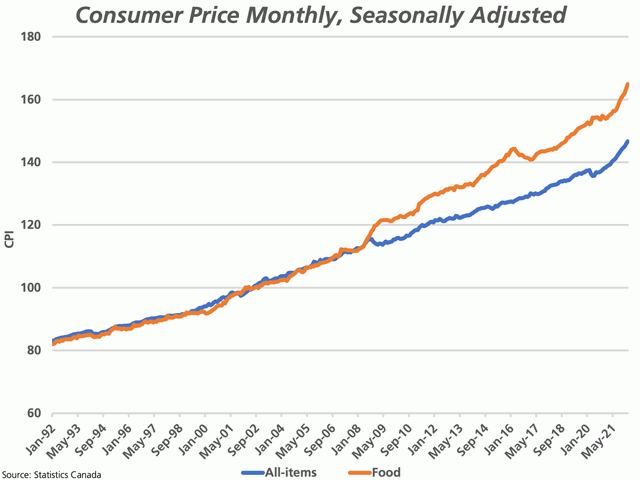Canada Markets
Canada's Food Inflation Findings May Be Too Hot to Handle
Food price inflation has long been a sensitive and controversial topic, perhaps now more than ever. Last fall in this space (https://www.dtnpf.com/…) we discussed the accuracy of Statistics Canada's food inflation data, after the Toronto Star released a piece titled "Canada's food inflation figures are wrong, critics say -- mainly because just three grocers supply the data." (https://www.thestar.com/…)
Supply chain interruptions and their effect on prices throughout the COVID-19 pandemic has led to increased focus on food supply and prices, which has since been perpetuated by Russia's invasion of Ukraine, which has led to increased focus on global food security.
Government policy, such as Canada's escalating carbon tax that has been described as a tax on everything that moves, is also a contributor to food prices, adding to the cost of living that disproportionately affects lower-income consumers. This tax is slated to rise in three days, on April 1, with the nation's carbon tax increasing by 25% -- from $40/metric ton to $50/mt. On Monday, Alberta Premier Jason Kenny conducted a press conference at a grocery store, calling on the federal government to scrap its "April Fool's Day prank," while plans exist to continue to increase this tax to $170/mt. Alberta's Premier has stated that food costs in the province have risen by 18% since the carbon tax was first introduced in 2015.
Despite food costs squarely on the radar, Troy media released a weekend piece written by Dr. Sylvain Charlebois titled "Why is StatsCan deleting its food inflation database?" (https://troymedia.com/…)
P[L1] D[0x0] M[300x250] OOP[F] ADUNIT[] T[]
In this piece, Charlebois pointed to soon-to-be made updates in the way Statistics Canada captures food price data. This includes important changes that will see redundant food products dropped from the list, along with numerous new products that will be added. "This new list will likely be more reflective of the modern diet," stated Charlebois. This includes bringing this report closer to Canada's most recent food guide, which is now three-years old.
Here's the problem. As indicated by Charlebois, "According to Statistics Canada's note, once the new list is posted, we won't be able to go back beyond March 2022 to access food prices. So getting any historical perspective on the new food basket won't be possible."
He goes on to say, "However, this move is generally not great news for Canadians. We can only believe StatsCan is admitting its reading of food inflation over the last few years has been inaccurate and that its approach needed a complete overhaul."
Charlebois suggests that Canadians keep weekly flyers as a means of tracking short-term moves in prices.
At the bottom of Statistics Canada's February Consumer Price Index report, the agency stated, "The Monthly Average Retail Prices for Food and Other Selected Products (table 18-10-0002-01) table will no longer be published after March 16, 2022. Note that these tables are not directly comparable due to methodological differences, and do not contain all the same products and may contain different product definitions." (https://www150.statcan.gc.ca/…)
My guess is that this statement was widely missed, and users of this data will not receive this information well. Perhaps users should decide how data can be utilized, rather than to delete 25 years of price data.
Cliff Jamieson can be reached at cliff.jamieson@dtn.com
Follow him on Twitter @Cliff Jamieson
(c) Copyright 2022 DTN, LLC. All rights reserved.






Comments
To comment, please Log In or Join our Community .